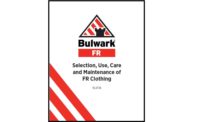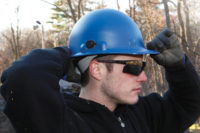For these reasons, it is important that safety managers be aware of the variety of hard hats and related features available as well as their proper use and care. This article looks at the top six considerations for selecting and maintaining head protection that will properly protect workers in any industry.
1 Selecting the right type
When it comes to selecting a cap, consider performance first. OSHA and the Canadian Standards Association require compliance with ANSI Z89.1-2009 and CSA Z94.1 standards respectively, and each standard specifies two levels of protection. Hard hats labeled ANSI Type I/CSA Type 1 are intended to protect the wearer against impact to and penetration of the crown, or top, only. These are most commonly worn in the U.S. By contrast, ANSI Type II/CSA Type 2 hard hats protect against both lateral and crown impact, and are more commonly worn in Canada due to safety standards there.
While Type II/Type 2 hats are slightly larger, heavier and can sometimes be warmer to wear, the added level of protection they provide can be lifesaving. In fact, the adoption of Type II hats is on the rise in the U.S. as employers become increasingly aware of the added protection they provide. Evaluate your site’s hazards to determine the right type of protection. When selecting Type II/Type 2 hats, look for features such as liners that allow ventilation to encourage safe, comfortable all-day wear.
2 Electrical hazards
In environments where workers can be exposed to electrical hazards, hard hats must protect against electrical shocks, burns and electrocution. Dielectric hats are designed to do just that. Available in two classes, Class E hard hats protect at up to 20,000 volts and class G hats protect at up to 2,200 volts. Class C hats are conductive, meaning they allow the flow of electric current to pass through the hat to the wearer. The ANSI and CSA ratings for dielectric hats are the same and can be found molded into the underside of the brim. Be sure to do a hazard assessment of the worksite to determine the total amount of possible voltage exposure and whether dielectric protection is required.
Also consider the mounting systems used to attach additional face or hearing protection to hard hats. The attachment system may change the dielectric rating of the cap. Confirm whether the chosen mounting system is safe for use. Finally, never drill holes into a cap, as this severely affects the cap’s dielectric properties.
3 Suspension options
A hard hat’s suspension is the internal framework that helps absorb and distribute energy upon impact. Hard hats generally come with four-, six- or eight-point suspensions. The number of points represents how many connections exist between the suspension and cap. Caps with more suspension points have a greater ability to spread weight — and impact — over a wider area. That can help minimize the after-effects of an impact by minimizing the amount of shock delivered on impact. Furthermore, more suspension points mean added comfort and stability. Because the weight of the hat is distributed more evenly, it feels lighter, and its greater adjustability reduces the hat’s tendency to wobble. Nonetheless, all three suspensions deliver the same level of impact protection to meet ANSI and CSA regulations.
Suspensions come in a variety of materials, including fabric, nylon ribbon and plastic. Base your selection on comfort and adjustability. In most cases, a suspension with an interchangeable sweatband is preferable. If you change a cap’s suspension, you must replace it with one from the same manufacturer to ensure it meets protection criteria. Shells and suspensions are tested — and perform — as a complete system.
4 Reverse donning
Wearing a safety cap backwards is commonplace. However, not all caps are intended to be worn backwards. Those not approved for reverse wear may put an individual at risk of serious injury when worn backwards. To address the popularity and liability of reverse donning, ANSI updated its 2009 standard to include an optional reverse donning test for caps. Today, hard hats meeting the standard for reverse wear are marked with a symbol depicting two arrows adjoined in a circle.
To reverse a cap, many models require the wearer to remove the suspension, reverse it, then reinstall it. This process can take several minutes to perform and, to do so safely, the worker should exit the hazard area. This not only costs valuable time, but also puts the wearer at significant risk if the suspension is not reinstalled properly. Look for hard hats with suspensions that are easy to reverse. Caps with swing-hinge headgear take only seconds to reverse, without removing the suspension, thus improving worker compliance, safety and productivity.
5 Daily inspection
Both ANSI and CSA guidelines require end users to conduct a thorough inspection of their hard hats and suspension before each use. Visually inspect the hat for evidence of cracking and gouging, and replace the hat immediately if any is found. If the hat suffers from any type of impact or impalement, or has experienced a fall greater than eight feet, replace it immediately even if there is no visible damage.
Next, check the structural integrity of the cap. Many conditions adversely affect the hat’s useful lifespan, including ultraviolet exposure, temperature extremes, chemical exposure and daily wear. Prolonged exposure to sunlight can degrade the shell and lead to flaking or crazing. Extreme temperatures can also impact protective properties. ANSI requires hard hats to perform properly in temperatures ranging between zero- and 120-degrees Fahrenheit. Hats used in temperatures outside this range should be tested and approved accordingly. Chemicals, such as those found in paint and insect repellant, interfere with the performance and integrity of the hat and/or suspension. For this reason, it is recommended that a hard hat never be painted or sprayed with any chemicals.
Finally, inspect the suspension. Check to ensure the fabric is not frayed or torn, and plastic parts are not cracked or damaged. If the suspension exhibits signs of fraying, tearing or cracking, replace it immediately.
While ANSI and CSA do not regulate the service life of protective caps, the industry recommendation is to replace a hard hat shell every five years and the suspension every 12 months from its first day of service. An easy way to track a cap’s service life is by noting its first day of service on the ANSI or CSA label found inside the hat.
6 Size and fit
Next to protection, wearer comfort is the second most important feature of a hard hat. Studies prove that uncomfortable caps are not worn consistently, leaving workers vulnerable to injury. To achieve a comfortable fit, take into account the number of suspension points, the type of suspension material and headband options. To ensure a safe fit, hats must be worn as snugly as possible, so consider sizing and adjustability options. Sizing is most popularly adjusted by pin locks or rachets, though other options such as sliding bands are available, making resizing the cap quick and easy. If the cap will require frequent resizing, look for adjustability features that are fast and easy to use.
By selecting the right hard hat — one that delivers both maximum protection and all-day comfort — you can ensure a healthier, more productive workforce.





